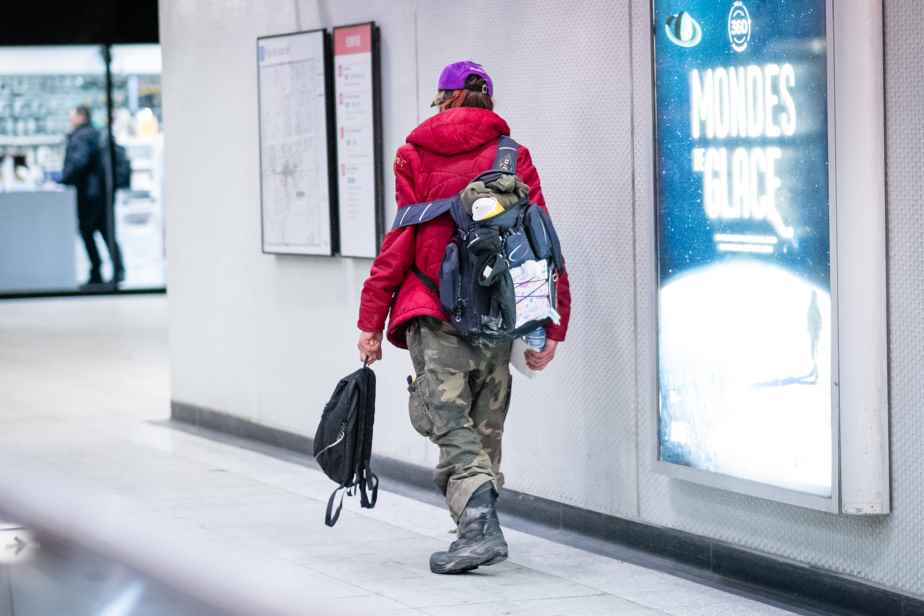The community services that work in the Berri-UQAM station sector have observed an increase in the frequentation of the premises by increasingly aggressive vulnerable people. And they have solutions to offer.
“There are a lot of people we’ve never seen on the street,” says Jean-François Mary, general manager of Cactus Montréal, an organization that supports drug users, located a few blocks from Berri-UQAM.
However, some of the newcomers do not share the same codes as those who have been there for a long time, observes the director. “There is a self-regulation that unfolds in these circles, he explains. With many people who don’t know these codes, it upsets a balance. »

PHOTO CHARLES WILLIAM PELLETIER, ARCHIVES SPECIAL COLLABORATION
Vulnerable person in the Berri-UQAM metro station, last Wednesday
According to François Raymond, director general of the Société de développement social – which has three social intervention projects in the Montreal metro –, the increase in aggressiveness is generalized. “For the past year or two, the users we work with have been more stressed, more aggressive,” he points out. It makes you wonder if there is something more to narcotics. »
Last Saturday, The Press reported that both consumers and dealers of drugs and the police are seeing an increase in violence at the Berri-UQAM station, in the wake of Archambault’s announcement to close his emblematic store on Sainte-Catherine Street. The sector would also be deserted by organized crime.
Solution 1: avoid the “ghettoization” of Berri-UQAM
Marginalized people in the city center are becoming less and less accepted in public spaces, laments Mr. Mary. The revitalization of Square Viger, Place des Montréalaises, Place de la Paix, the development of the Quartier des Spectacles and below the Jacques-Cartier Bridge have contributed to modifying the urban space, he recalls.
“We dispossessed these populations of places through the privatization of spaces, police repression and public events,” he argues.
As a result, people who previously managed to avoid each other on the street often find themselves forced to live together in the same areas.
“It creates tension and it increases aggressiveness, deplores Mr. Mary, in addition to the fact that people have the impression that they are not welcomed anywhere. »
A vision shared by Annie Aubertin, Executive Director of Specter de rue, another organization helping drug addicts in the Village. “The more people are turned away, the more they find themselves stuck in the same place. We should have real cohabitation plans where people are not automatically driven out of places dedicated to the general public and not to homelessness, ”she believes.
Solution 2: Supervise crack use
Both Cactus Montréal and Specter de rue have supervised injection sites, where drug users can use drugs safely within their walls.
However, the places are not suitable for people who use crack by inhalation, as is often the case in the Berri-UQAM sector. Investments in infrastructure are needed to allow for increased ventilation.
“On our side, the plans are made, but it is a question of financing, supports Mme Aubertine. It almost worked with the CIUSSS a few years ago, but because of the pandemic, it was slowed down. But it is indeed a project that is close to our hearts. »
“It is clear that, for us, it is a will, because we know our neighborhood,” adds Mr. Mary.

PHOTO CHARLES WILLIAM PELLETIER, ARCHIVES SPECIAL COLLABORATION
No supervised consumption site in Montreal allows the sniffing of drugs.
Currently, there are no supervised consumption sites in Montreal that allow drug sniffing.
Maison Benoît Labre, which is building new premises in the southwest of the city, will soon become the first organization to offer this service.
According to coordinator François Giroux, this new site will make it possible to prevent overdoses linked to inhalation, to prevent the risk of contracting HIV and hepatitis C, as well as to improve public safety by preventing people from consuming in public areas.
Solution 3: more police presence and housing
According to François Raymond, neither the question of cohabitation nor the supervised consumption sites alone will resolve the difficulties at Berri-UQAM.

PHOTO CHARLES WILLIAM PELLETIER, ARCHIVES SPECIAL COLLABORATION
Police in the Berri-UQAM metro area, last Wednesday
“There really needs to be more police presence,” he said. They are the dealers drugs that need to be stopped. It has to hit everywhere at the same time, otherwise it’s going to be a stab in the water. »
“It takes more tolerance in society, but also parallel measures for people who want housing and longer-term support,” adds Ms.me Aubertine. The housing that is available is far too expensive for people living on the streets. »
Learn more
-
- 35,000
- Number of unique clients of supervised consumption sites in Canada, between 2017 and 2019
- 2 millions
- Number of visits to supervised consumption sites in Canada, between 2017 and 2019
SOURCE: Government of Canada
